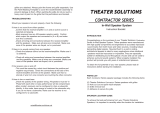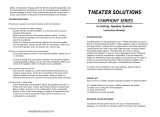Page is loading ...

Owner’s Guide
ERS 110,ERS 210

Infinity ERS Series
The ERS Series of in-wall/ceiling loudspeakers continues
Infinity’s longstanding commitment to accurate sound
reproduction.Our patented Ceramic Metal Matrix Diaphragm
™
(C.M.M.D.
™
) drivers and precision dividing networks deliver
uncompromised performance in any stereo,multichannel home
theater or whole-house music system.
Unpacking the Speakers
Carefully unpack the speakers.If you suspect damage from
transit,report it immediately to your dealer and/or delivery
service.Keep the shipping carton and packing materials for
future use.
I
NTRODUCTION
Template/paint shield.
Remove paint shield (inner
circle) at perforation.
ERS 110
ERS 210
2
P
LANNING
Y
OUR
S
YSTEM
Before deciding where to best place your speakers, survey your
room and study Figures 1 and 2.
Couch
Left
Front
Channel
Right
Front
Channel
Infinity Subwoofer
(optional)
Couch
Left
Front
Channel
Left
Surround
Channel
Right
Surround
Channel
Right
Front
Channel
Center
Channel
Infinity Subwoofer
(optional)
Figure 2. This overhead view shows a typical home theater plan.
Figure 1.
One pair of speakers with grilles.
Template/paint shield.
Remove paint shield (inner
rectangle) at perforation.
One pair of speakers with grilles.
NOTE: Figures 1 and 2 show recommended speaker locations.
You may also follow these general placement suggestions when
installing the speakers in the ceiling.

P
LACEMENT
Stereo
Before deciding where to place your ERSSeries speakers,
survey your room and think about placement,keeping the
following points in mind,and using Figure 1,on previous page,
as a guide:
• For best results,place the speakers 6'–8' apart.
• When installing in the wall,position each speaker so that the
tweeter is as close to ear level as practical.
• Refer to “Home Theater”below if you also plan to use the
speakers in a home theater system.
Home Theater
For front-channel use,place one speaker on the left and another
on the right along either side of the television.
A center channel speaker should go directly above or below the
television and can be an in-wall or freestanding center channel.
Forrear-channel use,install the speakers alongside the
listening position.
NOTE:An Infinity powered subwoofer will add impact and
realism to both music and film soundtracks.Contact your
Infinity dealer for recommendations on subwoofer models for
your application.
Proper placement of the speakers is an important step in
obtaining the most realistic soundstage possible.These
recommendations are for the optimum placement of the
loudspeakers.Use these placement recommendations as a guide.
Slight variations will not diminish your listening pleasure.
Ideally,the front speakers should be placed the same distance from
each other as they are from the listening position.
In a home theater configuration,the two surround speakers should be
placed perpendicular to the listening position.If that is not possible,
they may be placed in a wall/ceiling behind the listening position.
The
surround speakers should not call attention to themselves.They
should provide a diffuse,ambient sound accompanying the main
program material heard in the front speakers.
3
I
NSTALLATION
The ERSSeries in-wall speakers were
designed to be easily installed.
However,if you are unsure of your ability to properly install these
loudspeakers,please contact your dealer or a qualified installer.
Phillips #2 screwdriver
Measuring tape
Utility knife
Pencil
Carpenter’s level
Awl
Tools Needed

S
PEAKER
C
ONNECTIONS
Turn Off All Power
Before completing the installation,you must connect your
speakers to your system.First,turn off all audio-system power.
Use high-quality speaker wire to make your connections.Use at
least #16-gauge speaker wire with polarity coding.Heavier
gauge wire is recommended for larger distances.Consult the
chart below left or your dealer for recommendations.The side of
the wire with a ridge or other coding is usually considered
positive polarity (i.e.,+). Also,consult the owner’s manuals that
were included with your amplifier or receiver to confirm
connection procedures.
Observe polarities when making speaker connections,as shown
in Figure 3.Connect each + terminal on the back of the
amplifier or receiver to the respective + (red) terminal on each
speaker.Connect the – (black) terminals in the same way.
Important!
Do not reverse polarities (i.e.,+ to – or – to +) when making
connections.Doing so will cause poor imaging and diminished
bass response.Be certain that positive and negative wire strands
are completely isolated to avoid short circuits that may damage
your equipment.
Wire Length Recommended Size
Up to 50 ft. 18 gauge
Up to 100 ft. 16 gauge
Greater than 100 ft. 12 gauge
4
Figure 3.

5
ERS 210
1.Remove the grille from the
speaker frame.
2.Determine the correct speaker
location.
Note: Remove the inner template,
which is the paint shield,at the
perforation.Use the outer
template when cutting the
drywall.
3.Note: Always allow at least
one-half inch between a wall
stud and the speaker cutout or
the locking tabs will not be able
to swivel into place.
≥1/2"
≥1/2"
≥1/2"
4.Cut the drywall.
5.Connect the speaker wires
to the speaker.
8.Replace the metal grille.
6.Place the speaker
assembly in the wall.
7.Screw down each of the six
Phillips head screws.The locking
tabs will swivel into place and
secure the unit to the rear
surface of the drywall.
ERS 110
1.Remove the grille from
the speaker frame.
≥1/2"
≥1/2"
≥1/2"
4.Cut the drywall.
Note:Always allow at least one-
half inch between a wall stud and
the speaker cutout or the locking
tabs will not be able to swivel into
place.
5.Connect the speaker wires
to the speaker.
6.Place the frame assembly
in the wall.
7.Screw down each of the four
Phillips head screws.The locking
tabs will swivel into place and
secure the unit to the rear surface
of the drywall.
8.Replace the metal grille.
3.Note: Remove the inner template,
which is the paint shield,at the
perforation.Use the outer template
when cutting the drywall.
E
XISTING
C
ONSTRUCTION
2.Determine the correct speaker
location.
Note: Remove the inner template,
which is the paint shield,at the
perforation.Use the outer
template when cutting the
drywall.

6
If you wish to preinstall a rough-in frame before drywall is
installed,you will need to purchase the correct rough-in-frame
kit for your model:
Speaker Model Rough-In-Frame Kit
ERS110 ERS110RIF
ERS210 ERS210RIF
Detailed installation instructions are supplied with the rough-in
kit.
Painting the Speaker Frame and Grille
ERS Series loudspeakers can be painted to match any décor.If
you wish to change their color,the satin finish on the grille and
frame will function as a primer coat.Before painting,install the
paint shield (inner section of template in the assembly kit)
securely into the recess in the baffle.This will protect the
speaker components and baffle from paint residue.Use a
high-quality spray paint,and apply a thin coat of color.
Be certain the grille perforations remain free of paint.Filling
them with paint will diminish the sound quality.
Note:
Gently remove the acoustical foam blanket from the grille
before painting.Reattach the blanket after the paint has dried.
O
PERATION
Surround Modes
When using the ERS Series in a Dolby* ProLogic* home theater
system,make sure the receiver’s center channel mode is set to
“Normal.”When using the system in a Dolby Digital or DTS
®
home theater system,make sure all speakers are set to “Small”.
Some Dolby Digital-equipped receivers/processors offer
different setup options for each source or surround mode,e.g.,
CD-stereo,videotape,Dolby,Pro Logic.In each case,follow your
equipment’s instructions to ensure that the subwoofer (if you
have one) output is turned on and that the speakers are set to
“Small”in each mode.
N
EW
C
ONSTRUCTION

7
ERS Series ERS 110 ERS 210
Frequency Range 50Hz – 20,000Hz (±3dB) 48Hz – 20,000Hz (
±3dB)
Recommended Maximum
Amplifier Power 125 watts 125 watts
Sensitivity (2.83V @ 1 meter) 88dB 88dB
Nominal Impedance 8Ω 8Ω
Crossover Frequency 2300Hz;24dB/Octave 2300Hz;24dB/Octave
Low-Frequency Driver 6-1/2" (165mm) C.M.M.D. 6-1/2" (165mm) C.M.M.D.
High-Frequency Driver 3/4" (19mm) C.M.M.D. 3/4" (19mm) C.M.M.D.
External Dimensions (W x H) Diameter: 9-3/16" (233mm) 8-3/4" x 12-3/4" (222mm x 324mm)
Mounting Cutout Size (W x H) Diameter:7-7/8" (200mm) 7-5/8" x 11-3/8" (193mm x 288mm)
Mounting Depth 3-1/2" (89mm) 3-1/4" (83mm)
Weight 3.1 lb (1.4kg) 3.5 lb (1.6kg)
Infinity continually strives to update and improve existing products,as well as create new ones.
The specifications and construction details in this and related Infinity publications are
therefore subject to change without notice.
S
PECIFICATIONS
Declaration of Conformity
We, Harman Consumer International
2, route de Tours
72500 Chateau-du-Loir
France
declare in own responsibility, that the products described in this
owner’s manual are in compliance with technical standards:
EN 50081-1:1992
EN 50082-1:1997
Robin Marshall
Harman Consumer International
Chateau-du-Loir, France. 6/02

© 2002 Infinity Systems,Inc. 250 Crossways Park Drive,Woodbury,NY 11797 USA 800.553.3332 (USA Only) www.infinitysystems.com
*Trademarks of Dolby Laboratories.DTS is a registered trademark of Digital Theater Systems,Inc. Ceramic Metal Matrix Diaphragm (C.M.M.D.) patent no.6,327,372.
Infinity is a registered trademark of Harman International and Infinity Systems,Inc.,a subsidiary of Harman International. Part No.:AI0503
1/8

